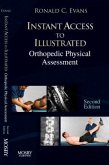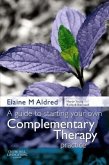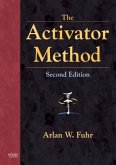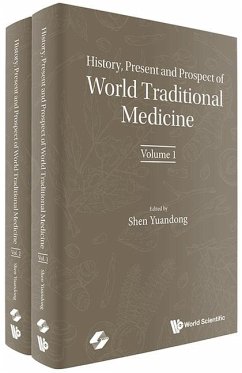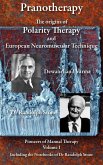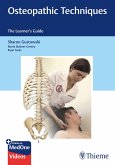Eyal Lederman
The Science & Practice of Manual Therapy
Schade – dieser Artikel ist leider ausverkauft. Sobald wir wissen, ob und wann der Artikel wieder verfügbar ist, informieren wir Sie an dieser Stelle.
Eyal Lederman
The Science & Practice of Manual Therapy
- Gebundenes Buch
- Merkliste
- Auf die Merkliste
- Bewerten Bewerten
- Teilen
- Produkt teilen
- Produkterinnerung
- Produkterinnerung
This practical book offers an extensive examination of how manual therapy (MT) techniques work, and how to match the most suitable techniques to different conditions. Drawing on evidence-based research, it explores the physiological, neurological and psychophysiological responses of the human body to MT techniques. In doing so, it helps MT practitioners deliver a more effective and safer treatment for a broader range of conditions.
Andere Kunden interessierten sich auch für
![Instant Access to Orthopedic Physical Assessment Instant Access to Orthopedic Physical Assessment]() Ronald C. EvansInstant Access to Orthopedic Physical Assessment41,99 €
Ronald C. EvansInstant Access to Orthopedic Physical Assessment41,99 €![A Guide to Starting Your Own Complementary Therapy Practice A Guide to Starting Your Own Complementary Therapy Practice]() Elaine Mary AldredA Guide to Starting Your Own Complementary Therapy Practice38,99 €
Elaine Mary AldredA Guide to Starting Your Own Complementary Therapy Practice38,99 €![The Activator Method The Activator Method]() Arlan W. FuhrThe Activator Method96,99 €
Arlan W. FuhrThe Activator Method96,99 €![History, Present and Prospect of World Traditional Medicine (in 2 Volumes) History, Present and Prospect of World Traditional Medicine (in 2 Volumes)]() History, Present and Prospect of World Traditional Medicine (in 2 Volumes)271,99 €
History, Present and Prospect of World Traditional Medicine (in 2 Volumes)271,99 €![Pranotherapy - The Origins of Polarity Therapy and European Neuromuscular Technique Pranotherapy - The Origins of Polarity Therapy and European Neuromuscular Technique]() Phil YoungPranotherapy - The Origins of Polarity Therapy and European Neuromuscular Technique24,99 €
Phil YoungPranotherapy - The Origins of Polarity Therapy and European Neuromuscular Technique24,99 €![Osteopathic Techniques Osteopathic Techniques]() Sharon GustowskiOsteopathic Techniques46,99 €
Sharon GustowskiOsteopathic Techniques46,99 €![Psychosocial Elements of Physical Therapy Psychosocial Elements of Physical Therapy]() Hannah JohnsonPsychosocial Elements of Physical Therapy71,99 €
Hannah JohnsonPsychosocial Elements of Physical Therapy71,99 €-
-
This practical book offers an extensive examination of how manual therapy (MT) techniques work, and how to match the most suitable techniques to different conditions. Drawing on evidence-based research, it explores the physiological, neurological and psychophysiological responses of the human body to MT techniques. In doing so, it helps MT practitioners deliver a more effective and safer treatment for a broader range of conditions.
Produktdetails
- Produktdetails
- Verlag: Elsevier Health Sciences
- 2nd Revised edition
- Seitenzahl: 336
- Erscheinungstermin: 9. März 2005
- Englisch
- Abmessung: 254mm x 192mm x 27mm
- Gewicht: 881g
- ISBN-13: 9780443074325
- ISBN-10: 0443074321
- Artikelnr.: 21052065
- Herstellerkennzeichnung
- Libri GmbH
- Europaallee 1
- 36244 Bad Hersfeld
- gpsr@libri.de
- Verlag: Elsevier Health Sciences
- 2nd Revised edition
- Seitenzahl: 336
- Erscheinungstermin: 9. März 2005
- Englisch
- Abmessung: 254mm x 192mm x 27mm
- Gewicht: 881g
- ISBN-13: 9780443074325
- ISBN-10: 0443074321
- Artikelnr.: 21052065
- Herstellerkennzeichnung
- Libri GmbH
- Europaallee 1
- 36244 Bad Hersfeld
- gpsr@libri.de
Dr Eyel Lederman is Director, Centre for Professional Development in Manual Therapy, London, UK and a practicing osteopath. Eyal completed his PhD in physiotherapy at King's College London where he researched the neurophysiology of manual therapy. He is actively involved in manual therapy research at UCL, exploring the clinical use of functional stretching. Eyal regularly teaches manual therapy techniques and the physiological basis of manual therapy in different schools across the UK and abroad. He has published many articles in the area and is the author of Harmonic Technique, The Science and Practice of Manual Therapy, Neuromuscular Rehabilitation in Manual and Physical Therapies and Therapeutic Stretching: Towards a Functional Approach.
1. IntroductionSECTION 1 The effect of manipulation on the tissue
organization2. Manual therapy in the tissue dimension3. Assisting repair
with manual therapy4. Affecting fluid flow with manual therapy5. Assisting
adaptation: manual stretching6. Pain relief by manual therapy: the local
tissue dimension7. Overview and summary of Section 1ReferencesSECTION 2
Neurological organization in manual therapy8. Manual therapy in the
neurological dimension9. The motor system10. Proprioceptive stimulation by
manual therapy techniques11. Affecting the lower motor system with manual
therapy12. The adaptive code for neuromuscular re-abilitation13. Abilities,
inability and re-abilitation14. Treating the intact motor system:
behavioural and psychomotor dysfunctions15. Neuromuscular organisation in
musculoskeletal damage16. Re-abilitating the damaged motor system17. Pain
relief by manual therapy - neurological mechanisms18. Muscle tone19.
Overview and summary of Section 2ReferencesSECTION 3 Psychological and
psychophysiological processes in manual therapy20. Manual therapy in the
psychological/psychophysiological dimension21. Origins of therapeutic
potential of touch22. Psychological influences of manual therapy23.
Psychophysiology of manual therapy24. Manual therapy in the psychosomatic
field25. Touch as a therapeutic intervention26. Pain relief by manual
therapy: psychological processes27. Overview and summary of Section
3ReferencesSECTION 4 Overview and clinical application28. Overview and
clinical application of the science
organization2. Manual therapy in the tissue dimension3. Assisting repair
with manual therapy4. Affecting fluid flow with manual therapy5. Assisting
adaptation: manual stretching6. Pain relief by manual therapy: the local
tissue dimension7. Overview and summary of Section 1ReferencesSECTION 2
Neurological organization in manual therapy8. Manual therapy in the
neurological dimension9. The motor system10. Proprioceptive stimulation by
manual therapy techniques11. Affecting the lower motor system with manual
therapy12. The adaptive code for neuromuscular re-abilitation13. Abilities,
inability and re-abilitation14. Treating the intact motor system:
behavioural and psychomotor dysfunctions15. Neuromuscular organisation in
musculoskeletal damage16. Re-abilitating the damaged motor system17. Pain
relief by manual therapy - neurological mechanisms18. Muscle tone19.
Overview and summary of Section 2ReferencesSECTION 3 Psychological and
psychophysiological processes in manual therapy20. Manual therapy in the
psychological/psychophysiological dimension21. Origins of therapeutic
potential of touch22. Psychological influences of manual therapy23.
Psychophysiology of manual therapy24. Manual therapy in the psychosomatic
field25. Touch as a therapeutic intervention26. Pain relief by manual
therapy: psychological processes27. Overview and summary of Section
3ReferencesSECTION 4 Overview and clinical application28. Overview and
clinical application of the science
1. IntroductionSECTION 1 The effect of manipulation on the tissue
organization2. Manual therapy in the tissue dimension3. Assisting repair
with manual therapy4. Affecting fluid flow with manual therapy5. Assisting
adaptation: manual stretching6. Pain relief by manual therapy: the local
tissue dimension7. Overview and summary of Section 1ReferencesSECTION 2
Neurological organization in manual therapy8. Manual therapy in the
neurological dimension9. The motor system10. Proprioceptive stimulation by
manual therapy techniques11. Affecting the lower motor system with manual
therapy12. The adaptive code for neuromuscular re-abilitation13. Abilities,
inability and re-abilitation14. Treating the intact motor system:
behavioural and psychomotor dysfunctions15. Neuromuscular organisation in
musculoskeletal damage16. Re-abilitating the damaged motor system17. Pain
relief by manual therapy - neurological mechanisms18. Muscle tone19.
Overview and summary of Section 2ReferencesSECTION 3 Psychological and
psychophysiological processes in manual therapy20. Manual therapy in the
psychological/psychophysiological dimension21. Origins of therapeutic
potential of touch22. Psychological influences of manual therapy23.
Psychophysiology of manual therapy24. Manual therapy in the psychosomatic
field25. Touch as a therapeutic intervention26. Pain relief by manual
therapy: psychological processes27. Overview and summary of Section
3ReferencesSECTION 4 Overview and clinical application28. Overview and
clinical application of the science
organization2. Manual therapy in the tissue dimension3. Assisting repair
with manual therapy4. Affecting fluid flow with manual therapy5. Assisting
adaptation: manual stretching6. Pain relief by manual therapy: the local
tissue dimension7. Overview and summary of Section 1ReferencesSECTION 2
Neurological organization in manual therapy8. Manual therapy in the
neurological dimension9. The motor system10. Proprioceptive stimulation by
manual therapy techniques11. Affecting the lower motor system with manual
therapy12. The adaptive code for neuromuscular re-abilitation13. Abilities,
inability and re-abilitation14. Treating the intact motor system:
behavioural and psychomotor dysfunctions15. Neuromuscular organisation in
musculoskeletal damage16. Re-abilitating the damaged motor system17. Pain
relief by manual therapy - neurological mechanisms18. Muscle tone19.
Overview and summary of Section 2ReferencesSECTION 3 Psychological and
psychophysiological processes in manual therapy20. Manual therapy in the
psychological/psychophysiological dimension21. Origins of therapeutic
potential of touch22. Psychological influences of manual therapy23.
Psychophysiology of manual therapy24. Manual therapy in the psychosomatic
field25. Touch as a therapeutic intervention26. Pain relief by manual
therapy: psychological processes27. Overview and summary of Section
3ReferencesSECTION 4 Overview and clinical application28. Overview and
clinical application of the science


